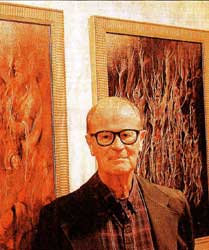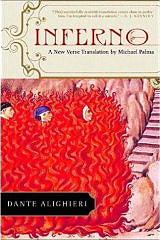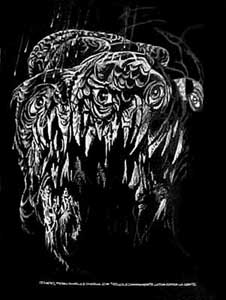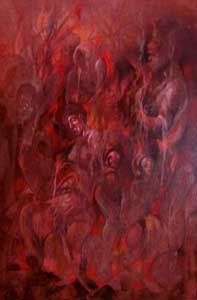Review
from
the Worcester Telegram
Sept 22, 2004
By Craig S. Semon
Inferno
sparks Artist
Images
of terror, torture inspired by Dante's Poetry
Fitchburg.--
Despite being hung in a clean, well-lighted space, the current
exhibit at Fitchburg State College's Hammond Gallery
resembles
the old "Night Gallery" television series with
its scenes of torture, torment and terror.
But instead of master story teller Rod Serling stalking in
the shadows and  creeping up behind you, patrons had master
multimedia artist
E. Thor Carlson chatting up a storm on "Dante's Inferno: Visual
Images from Hell" during the show's recent opening.
creeping up behind you, patrons had master
multimedia artist
E. Thor Carlson chatting up a storm on "Dante's Inferno: Visual
Images from Hell" during the show's recent opening.
"I like showing them in this space. It's an intimate space",
Mr. Carlson said. "Some gallery spaces are so huge.
Things get lost."
The bespectacled Gardner native, who calls Newport, N.H. his home,
brought a calming, rather than a chilling effect, to the surroundings
with his telling words, vibrant images and vigor for life.
"These new images were inspired by the poetry of the 'Inferno', which
is the beginning of a three-part poem, now called 'The Divine
Comedy' by Dante Alighieri," Mr. Carlson explained. "He called
it merely 'La Commedia'. At that time, the word comedy meant
that it had a happy conclusion rather than a foolish one."
Previous translations of 'La Commedia' never satisfied Mr. Carlson,
he said, and Longfellow's heavy-handed English version, he added,
would put him to sleep.
Finally, in the form of a new Italian-English
translation by Michael Palma ,
(published in 2003), Mr. Carlson found a version that captured
Dante's original vision without losing the richness
of its poetic
structure.
,
(published in 2003), Mr. Carlson found a version that captured
Dante's original vision without losing the richness
of its poetic
structure.
"He (Palma) has managed to use Dante's pentameter and rhyme," Mr.
Carlson said. "And I recommend it to anyone wanting
to enjoy this dismal trip, if that is possible, in English,
with triple
rhyming verses, just as Dante's Italian."
 While the exhibition is based on Dante's masterwork, depicting these
images is Mr. Carlson's reaction as an artist to the madness of war,
he said, with inspiration drawn, sadly, from the recent invasion
of Iraq.
While the exhibition is based on Dante's masterwork, depicting these
images is Mr. Carlson's reaction as an artist to the madness of war,
he said, with inspiration drawn, sadly, from the recent invasion
of Iraq.
"The verses from Hell, through poetry, create for me images of the
lost souls, the lost causes and the futility of the human condition
in time of war," Mr. Carlson continued. "War is
Hell. War is abhorrent. It solves nothing. There has to be
a better
way!"
Mr. Carlson admitted that he's not the first artist to be inspired
and to capture the infernal images that Dante imagined.
In addition to early illustrated manuscripts by unknown 14th century
artists, Dante's immortal text has been celebrated by artists such
as Sandro Botticelli, William Blake, Auguste Rodin, Gustav Dore and
Rico Lebrun.
As did his predecessors, Mr. Carlson started with images of Dante
and later, Virgil, his tour guide through Hell, within the described
settings.
He later had the epiphany that the viewers would be more directly
involved if they witnessed these horrific images first-hand.
Mr. Carlson said he wanted the viewer to get the feeling that he
was looking through Dante's eyes.
"Most of the illustrated versions I have seen have Dante
and Virgil in every single illustration and has less impact to
them. My desire was to hit you in the eyes with these rather
dreadful
scenes because
there is nothing pleasant about the Inferno and it was
never intended to be pleasant."
Mr. Carlson subjectively chose an image or two from each canto,
which he said he feels has power and is visually archetypal.
 |
Cerberus
|
"Of the 34 canti in 'Inferno', I have but scratched the surface," he
said. "Moreover, still yet to do are the other two
parts of the 'La Commedia', the 'Pergatorio' and the
'Paradiso'
with 34 more cantos each."
Mr. Carlson started his Inferno series as drawings using Cennino's
toned paper with black charcoal and white chalk, then he went to
black and white sgraffito (scratchboard) before shifting to paint
and canvas.
"I chose to use acrylic rather than oil because (with) acrylic I can
duplicate the old egg tempera technique in modern materials," he
said. "It's a very fast way of working, as opposed
to oil, which you very often have to wait for several
weeks
sometimes
for it to
dry. It enables me to work much faster while the idea
is still hot."
Some of the images of hell are so "hot" that
one might singe their eyebrows if they look too close.
 |
Everlasting
Fire
|
With
titles that include "The Door to Gloomy Hell Is Always
Open", "Behold Satan, the Emperor of the Realm of Misery", "The
Perpetual Fires", "The Fearsome Wood", "A Dark
and Savage Wood", and "The Wood of the Suicides",
Mr. Carlson gets his point across. Still, the artist
can't resist playing Devil's advocate.
"It's very experimental," he said. "There are some things
about it that I am very pleased with and others that I'm already
thinking about doing over in a different way."
But the exhibit is not all fire and brimstone.
While the Dante's "Inferno" segment is making its debut,
there are other recent, less hellish, works on display.
One work which was done in the 1980's (and in oils) but could
easily fit in the "Inferno"/ "Night Gallery" vein is "The
Watchers of Armageddon".
"It resulted actually from a dream in which these "people" were
watching the destruction of Planet Earth. I happen to think
that we are not alone in the universe,
so this my interpretation. It's not a pretty subject. It never
intended to be," Mr. Carlson
said. "I guess there is part of me that keeps wanting
to try to make images that have impact and there's the other
half that wants to make peaceful things."
 |
Portrait
of the Artist as an Old Tree
|
A
more whimsical work with its roots firmly planted in the ground
is the painting "Portrait of the Artist as an Old Tree".
"That, for me is a survivor," he surmised. I'm about to turn
80 in another year and I have been painting since I was
10.
The 1943 graduate of Gardner High School said he is touched
by the fact that younger generations seem to respond to his
work.
"That gives me a lot of energy and I'm always happiest it seems that
young people don't bat an eye at these things," he said. "I
think Hell is what we create ourselves."
